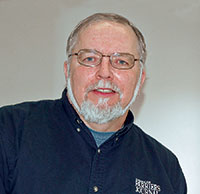The first time I ever saw a horse shod, the farrier was my college roommate, John Hart.
This was back in the early 1970s. John, who was a couple of years younger than me, had taken a spring term off from Ohio’s Bowling Green State University, where we were students, to go to horseshoeing school in Oklahoma.
John never intended to be a full-time farrier. But he did have a background with horses, liked working with them and was from a part of Ohio where there was a sizeable equine population. When he returned to Bowling Green the following fall, he picked up a few clients in the area, primarily horses of the backyard type.
One late fall day, he asked me if I’d like to ride along and watch him shoe a horse. He said he might need me to hold the horse.
A Sporty (But Unreliable) Shoeing Rig
I knew very little about horses and nothing about holding them. But I did know John’s car, a 13-year-old MG Roadster, that was notorious for not starting in cold weather. It was unlikely that I’d be needed to hold the horse, but it was better than even money that I’d wind up pushing the car down some farm lane until it reached a speed at which he could pop the clutch and start the engine.
(This also illustrates how little I knew about horseshoeing at the time. It didn’t even occur to me that there was anything strange about a farrier rolling up to an appointment in an old battered sports car that didn’t even have a back seat, let alone room for a shoe rack or an anvil.)
The horse was at a farm just a few miles outside of town. She was a stocky brown mare that the owner used for trail riding and 4-H Pony Club. The teenage girl who owned her led her outside her stall and into the afternoon sun. John got his homemade shoeing box from the tiny storage area of the MG and got ready to go to work.
Basic Tools
As I recall, his tools consisted of his shoeing apron, at least one hoof knife, nippers, a nail puller, a driving hammer, two rasps, a box of nails and what I later learned was a clinch block. He also had a hoof gauge and four keg shoes.
Again, showing how little I knew about horseshoeing at the time, I didn’t see anything unusual in the fact that John was only carrying four shoes. After all, the horse only had four feet. How many more would you need?
During my years as an editor at AFJ, I’ve tried to look back across the years and remember the details of that shoeing.
It was a cold shoeing job. I do remember that. It had to be. There was certainly no room for a forge in that old MG. John didn’t even have an anvil along (although he did tell me he had one at the workshop he was setting up in his hometown).
I don’t even recall John doing any shaping of the shoes. I do remember him saying he’d shod this mare before, so he knew what shape and size of shoe she needed, so he’d only brought the one set (that was the first time I realized horseshoes came in different sizes).
I recall him getting to work right away. In retrospect, I realize that John had a pretty good build for a farrier. He was only about 5-foot-6, compact and muscular. He seemed at ease while under and around the horse.
He pulled the old shoes and threw them into his shoeing box. He trimmed the feet, and then checked the trim using a hoof gauge. (I think that might have been the only time I asked what he was doing and why.) He then checked the fit of the shoes and went ahead and nailed them on.
He wrung the nails off and — I now realize — hammer clinched them. I remember being surprised at how much work there still was to be done once each shoe was in place.
I didn’t have a stopwatch, but he was done with the job in less than an hour.
Big Tipper
He had the girl trot the mare away from us and then back. They agreed the horse was moving fine. The owner put her horse back in the barn, while John packed his tools back into the car. She came back a moment later and handed my friend a cold can of Coca-Cola and a $20 bill. I distinctly recall her saying, “Keep the change.”
I don’t have any idea how much of a tip was involved. John passed away unexpectedly a number of years back. I never got the chance to talk to him about his shoeing in the light of what I’ve learned while working at AFJ.
He did get in a little dig as he slipped the bill into his wallet.
“Beats flipping pizzas,” he said. “You ought to think about doing this.”
I was working part-time at a local pizzeria — for the princely wage of $2.50 an hour. On the other hand, pizzas don’t bite, kick or stand on your feet. And while I’d enjoyed watching John work, I also recognized even then that John knew his way around horses and I didn’t. It was an educational experience, but I also figured I’d probably never see anyone shoe a horse again. You just never know, do you?
But it turns out I did know John’s car. I must have pushed that MG the length of a football field before he got it started.







